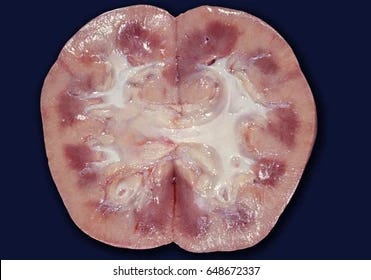Kidneys Fundamentals II
This is a continuation of my previous post, Kidney Fundamentals. The purpose of this post is similar to my original post in that:
Writing clarifies my thinking, however, given my lack of background in this field, writing alone won’t be enough to actually learn. I have found that the best way to learn something completely outside of my domain is to put my “understanding” up to debate and criticism. This forces me to ensure that my understanding is as good as can be due to fear of publicly embarrassing myself.
I know that there will be gaps and misunderstandings in my learning, so by “opening” it up it allows others to identify these issues and correct me.
It should be noted that I naturally have more questions than stated below. However, the purpose of learning these fundamentals isn’t to cover everything, but to cover just enough that I can start evaluating current solutions, possible solutions and come up with my own hypothesis.
It goes without saying that I was not able to answer all of the questions with a lot of detail, or even answer them at all, however this is to be expected as I am still learning how to evaluate academic sources properly and haven’t yet acquired lab experience.
Text in italics, not bold, are answers to the questions I had previously. Questions are highlighted in italics and bold.
How to read this
As you read through this document I highly encourage you to:
Actively look for mistakes and inconsistencies. In the likely case that you find them please mention them, publicly if possible, as this could probably help someone else with their understanding
Think of questions you think I ought to ask myself. In order to make fast progress towards my desired solution I need to be asking better questions, so any help here would be appreciated
If you think there is a better way I could approach my learning and problem solving, please do reach out, again publicly would be preferred
What does the Kidney do?
Most people are born with 2 kidneys each found on either side of spine just below rib cage
They constantly remove waste and water from blood to make up urine
The kidneys also removes acid from the blood, maintains balance between water and salts and minerals (including sodium, calcium, phosphorus and potassium)
If this balance isn’t maintained it impacts nerves, muscles and other tissues. Too much sodium causes high blood pressure. Too much potassium leads to irregular heartbeat, vomiting, nausea, muscle weakness. Too little potassium could lead to low blood pressure
Kidneys make hormones that maintain blood pressure, create red blood cells, keep your bones strong and healthy
Where and how does the kidney make these hormones?
It activates vitamin D which helps with absorption of calcium
Erythropoietin (also known as EPO during dialysis) is used to stimulate the creation of red blood cells from your bone marrow
Kidneys are made up of approximately 1 million filtering units (each) called nephrons. A nephron is a two part unit made up of 1) glomerulus and 2) tubule. The glomerulus filters your blood and the tubule returns your needed substances bad to your blood such as important minerals, and removes extra waste.
Is there a minimum number of nephrons a kidney needs to be functional, if so what is it?
It seems as though the answer to this is relative. On average humans are born with around 950,000 nephrons. However the range is from 200,000 < 2.5M. It seems as though the percentage loss of nephrons in an adult kidney is more important than the absolute nephron size it starts out with.
Is it possible to have too many nephrons, if so what is the impact?
Answered above.
Does the 3d structure of the kidney impact its function, if so?
The 3D structure does have an impact on the kidney's function. When comparing 2d cultures to 3d cultures there are some notable differences. For example, in 2D cells they all receive the same level of nutrients, whereas 3D cells receive different levels of nutrients as they are multilayered, with the inner layer receiving the least number of nutrients, causing them to be inactive.
Does the outside layer of the kidney serve any function, if so, what is it, and how does it do it?
Yes it does. The outer layer is known as the renal cortex and serves as a space for the arterioles and veins from the renal artery, vein and glomerular capillaries to enter the nephrons, in which they are filtered. It is also where EPO (Erythropotein) is produced (this hormone produces red blood cells). This layer is protected by 3 outer layers of fat to protect it from damage, connect it to surrounding tissue and provide it with stability (what does stability mean in this case?)
Does the size of the kidney matter? If it does, why?
The answer isn’t entirely clear. There is an expected kidney size (10-12cm), however, if it is less or more than this because of its fetal development then it is usually fine. If changes in the kidney occur in the adult stage then this can lead to kidney failure. This is usually due to some sort of disease or condition such as kidney stones, blocked urinary tract or long lasting kidney infection. The change in size of the kidney impacts blood flow and therefore ability to filter the body’s blood properly.
Does the shape of the kidney matter? If it does, why?
It is unclear why the kidney is bean shaped. The indent on the side of each kidney is called renal hilus. It is indented to provide space for the renal artery, renal vein and ureter
The glomerulus is a cluster of tiny blood vessels with thin walls that act as a filter. This allows smaller molecules and water to pass through. Bigger things like proteins and blood cells can’t pass through.
What are the material properties of the glomerulus and why?
The glomerulus is lined by fenestrated endothelia, which are endothelium cells with holes in them. The glomerular filtration rate is dependent on the size of these holes, which also contributes to the amount of protein let in and out
Does the 3d nature of the glomerulus have an impact on its function, if yes, how so?
No clear answer, but I assume it is the same answer as 3d vs 2d structure.
What is the glomerulus dependent on to do its job?
It is dependent on Starling's forces to filter the blood. The Starling's forces are made of hydrostatic pressure and oncotic pressure. They dictate which direction fluid flows and how much nutrients are extracted
What regulates the glomerulus as it does its job?
FF =GFR/RFR,where FF = filtration fraction; GFR = glomerular filtration rate; RPF = renal plasma flow. The afferent arteriolar (blood going into the glomerulus) dilation and efferent arteriolar (blood going out of the glomerulus) constriction increase the GFR and FF
The juxtaglomerular apparatus helps regulate glomerular filtration. If the baroreceptors (found in the carotid arteries) detect a low enough blood pressure there is a decrease in renal blood flow and a reduction in afferent arteriolar pressure and decrease in filtered solute. This triggers the release of renin.
Renin is a hormone that helps regulate blood pressure. It is part of the renin-angiotensin-aldosterone system
Renin converts angiotensinogen into angiotensin1
Angiotensin1 is the converted to angiotensin2
Angiotensin2 then narrows your blood vessels (how?) and stimulates the release of Aldosterone
Aldosterone helps retain more water in the body, which helps take in more salts and minerals. This increases blood pressure
The tubule runs alongside the glomerulus and filters the blood in there, reabsorbing nearly all the water and minerals. It removes excess acid from the blood too. The remaining fluid in the tubule is waste + water, also known as urine.
Why is extra water filtered out in the tubule? Why doesn’t all of the filtering happen in the glomerulus?
The glomerulus has a non selective filter, which filters out all of the negative and positive ions, including sodium ions. It does not filter out proteins and red blood cells (unless the membrane is damaged). The glomerulus filters based on size, not chemical, hence why a second layer of filtration is needed. It is not entirely clear why the glomerulus was designed this way, but I suspect this becomes an evolutionary question.
What are the material properties of the tubules and why?
The proximal convoluted tubule is covered in microvilli. This helps increase the surface area for reabsorption.
Reabsorption is done through active passing which requires energy
Does the 3d nature of the tubules have an impact on its function, if yes, how so?
The descending aspect of the loop of Henle is thin. This makes it highly permeable for water and impermeable for urea and ions. This is done through Aquaporin-1 channels. Water is leaving via osmosis as there is a high concentration of ions in the surrounding tissue. (Why is this happening?)
The ascending aspect of the loop of Henle does the opposite (impermeable to water but permeable to urea and ions). It does the opposite because there are no Aquaporin-1 channels. The movement of sodium, potassium and chloride is done through secondary active transportation using Na-K-Cl co-transporter.
Why does this need to be loop shaped?
I suspect this has something to do with the surrounding tissues and organs, each section needing different things, along with the shape of the loop increasing the surface area (which probably gets/gives its solutes faster).
What is the tubule dependent on to do its job?
Answered above.
What regulates the tubule as it does its job?
Answered above.




Love this.k